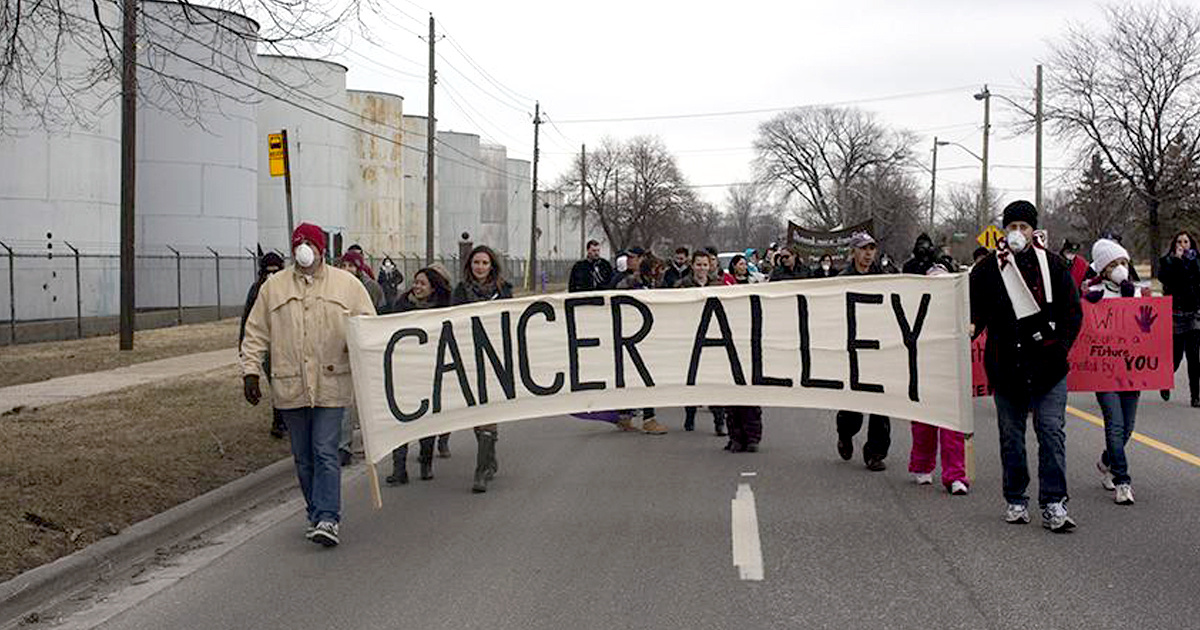

Good Morning POU!
Cancer Alley is the regional nickname given to an 85-mile (137 km) stretch of land along the Mississippi River between Baton Rouge and New Orleans, in the River Parishes of Louisiana, which contains over 200 petrochemical plants and refineries. As of 2012, this area accounted for 25% of the petrochemical production in the United States. By the 1970s the EPA documented serious water and air pollution. Environmentalists consider the region a sacrifice zone where rates of cancer caused by air pollution exceed the federal government’s own limits of acceptable risk.

Following an oil and gas boom around the time of World War II, a number of refineries spawned along the Mississippi River near the Gulf Coast. Many of these facilities were previously located in major population centers, such as Baton Rouge and New Orleans, but during the 1950s, many sought to migrate to less densely populated places. Many relocated to the small communities along the river between New Orleans and Baton Rouge, often located on former plantation sites adjacent to communities with significant or majority African American populations.
By the 1970s, the area had a proliferation of plants producing vinyl chloride, nitrogen fertilizers, and chlorine. By the 1970s, serious air pollution and water pollution was noted by federal agencies. An EPA report found 66 pollutants in New Orleans drinking water, and 31 lethal chemicals in the air of Plaquemine. In 1976, Coast Guard divers retrieving sediment samples from a bayou suffered second-degree burns on their hands. By the early 1980s, residents in the neighborhood of Good Hope had grown accustomed to regular fires at a local oil refinery, and developed their own informal evacuation plans for their occurrences. Despite the known problems with pollution, the petrochemical industry in the area continued unabated, and even continued expanding. In the early 1980s, an oil refinery purchased the land of Good Hope for expansion.

Beginning in the 1980s, locals also perceived certain species of plants and animals becoming less common. By 1988, locals began referring to an area in Chalmette in St. Bernard Parish as “Cancer Alley”. The “alley” later grew to encompass an eighty-five-mile stretch along the Mississippi River stretching from New Orleans to Baton Rouge and includes the parishes of East Baton Rouge, West Baton Rouge, Iberville, Ascension, St. James, St. John the Baptist, St. Charles, Jefferson, Orleans, St. Bernard, and Plaquemines.
Industrial plants emitting toxic waste in Louisiana continued to proliferate in the 21st century. According to EPA data, the number of industrial plants in Louisiana that reported their toxic releases grew from 255 to 320 from 1988 to 2017, an increase of 25%, even as the number of such plants nationwide dropped by 16% over that period.
Per a 2003 study that surveyed 11 plants in St. James Parish, researchers found that the plants employed between 4.9% and 19.4% African Americans, which is low in comparison to the overall population of the county (49.2% in 2000).

In 1969, DuPont opened a plant to manufacture the chemical chloroprene, the main ingredient in neoprene, in Reserve, Louisiana on the border with LaPlace, Louisiana. The plant was sold in 2015 to Japanese chemical company Denka. The area immediately adjacent to the Denka/DuPont neoprene plant in St. John the Baptist Parish has been recognized by the EPA as having a likelihood of its residents getting cancer from air pollution over 700 times the national average. According to EPA, it emits 99% of the nation’s chloroprene pollution. EPA opened civil rights investigations over this pollution from Cancer Alley.
The EPA, in both 2016 and 2020, reported that those residing in Cancer Alley are exposed to more than 10 times “the level of health risk from hazardous air pollutants” than other residents in the state. Human Rights Watch reviewed data from 12 fossil fuel and petrochemical plants operating in the Cancer Alley area from October 2020 to November 2023. Out of these 12 facilities, only one of them was “reported in compliance with all three federal laws” in the 3-year observational period. Only 2 of these facilities “were in compliance with the Clean Water Act” as well.
On January 27, 2021, President Joe Biden signed an executive order regarding environmental justice and specifically cited Cancer Alley as a hard-hit area. Louisiana Chemical Association President Greg Bowser responded to President Biden’s remarks on the region, refuting claims that residents of the industrial corridor have a higher risk of developing cancer in multiple articles.
On March 7, 2025, the Justice Department announced it was dropping the federal case against Denka’s Louisiana elastomer plant, which the Biden administration had sued over alleged increased cancer risks in the local, mostly Black community. The DOJ linked the withdrawal to Trump’s policy of ending federal DEI initiatives.
